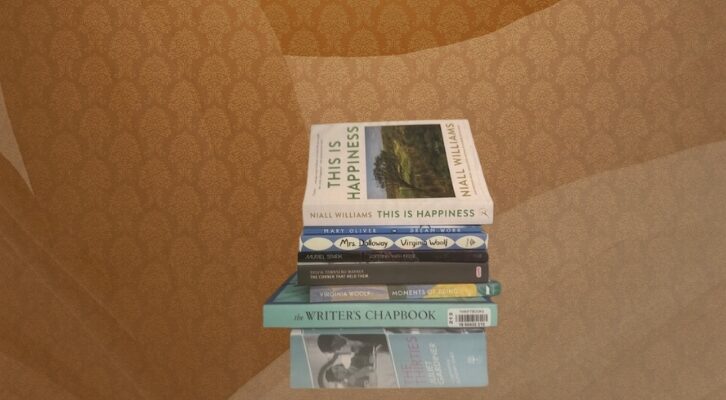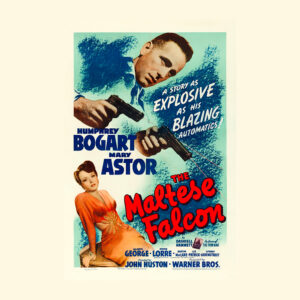
The Annotated Nightstand: What Sonya Walger Is Reading Now, and Next
Featuring Niall Williams, Mary Oliver, Muriel Spark, and Others
At the beginning of the year, the equivalent of an eighth of Los Angeles burned down, an unfathomable amount. Like many in Los Angeles, the fires have left me physically unscathed but heartbroken for the innumerable losses.
The other day, I accidentally found myself driving through Altadena on its main drag and was stunned to see, alongside pristine magnolia trees and homes, car carcasses reduced to ash, entire buildings and homes now bent rebar and brick fireplaces. I knew so much had burned, but still felt blindsided by the destruction. My heart broke, newly, for these two communities, now in chemically infused “burn scars” and on a long road to recovery.
Sonya Walger, the author of the recently published autobiographical novel Lion, was one of the many who lost her home in the fire. I am grateful to be able to have this column hold an example the particular loss of one’s library means for a writer and book lover. (Walger also hosts the podcast Bookish.)
Lion has the general markers of autofiction—the protagonist’s name is the same as the author, she grows up in England, studies literature at Oxford, becomes an actor in America. Lion is a love letter to Sonya’s father, affixed with a prickly seal. Through propulsive vignettes, we get a portrait of a man who is the star of his own show, his daughter understandably rapt.
“My father lives like the skydiver he will become,” Walger writes. “He spends his life leaping into the unknown, defying the laws that govern everyone else, and waiting for the consequences to catch up with him later.” Indeed, as Walger illustrates, he is a man who is handsome and charming, the best storyteller in the room.
And he certainly has stories to tell—the plane crash in Paraguay he miraculously survives, the endless ventures he somehow pulls off. Yet he also is a charlatan who shams his way through his innumerable problems, trouble with money and cocaine nipping at his heels.
While perhaps tolerable or even enjoyable if one is at a remove, as a young child of such a person, your relationship is invariably defined by longing. “It’s hard to compete with adrenaline when you are a child,” Sonya explains.
Living in different hemispheres certainly doesn’t help. Sonya’s parents split not long after her birth, and her father returned to his home country of Argentina. “Ours is the love affair of the glamorous,” writes Walger. “We meet in Barbados, Lima, Cuzco, Paris, Buenos Aires. We have no chance to become routine to each other because repetition requires time.”
Thus, in portions that begin with her age (“I am five and six”), we see moments of Sonya’s life as well as brief visits with her father. He gives her periodic affection, chaotic experiences, and showers her with endless promises. Walger spares us the torturous wait Sonya will experience by punctuating these declarations with, simply, “(he never does).”
He is a father who asks what she did that day rather than how she is. As Sonya explains, “I seem always to be giving my father a guided tour of my life.”
Walger tells us about her to-read pile, “This stack depicts the books I grabbed as I left my home for what turned out to be the last time. It’s a bittersweet image of research and comfort.”
*

Niall Williams, This Is Happiness
Elizabeth Graver writes of This Is Happiness for the New York Times:
Williams has painted a lush, wandering portrait of Faha, a village back in time in County Clare, Ireland, a place also featured in his previous novel, History of the Rain, which was longlisted for the 2014 Man Booker Prize. History of the Rain is powerfully narrated by a young, bedridden woman who tells stories of her dead father’s life while devouring the books in his library.
In this new work, the narrator, Noe, is a seventy-year-old man looking back roughly sixty years to the spring of 1958, when he dropped out of the seminary after his mother’s death and, full of fear and unprocessed grief, went to live with his grandparents in Faha, where he’d spent time as a child. This Is Happiness is as full of detours and backward glances as it is of forward motion and—as befits a novel narrated by an old man who comments that “as you get toward the end, you revisit the beginning”—is centrally preoccupied with time itself.

Mary Oliver, Dream Work
This poetry collection was reissued last year, but I love to dig for an original review. Holly Prado wrote in the Los Angeles Times in 1987.
The music in Oliver’s writing is unmistakable. Her poetry can be read as the best of the real lyrics we have these days, and it’s no surprise that she’s already won a Pulitzer Prize for it, as well as many other honors. It carries the energy of the ancient poetic tradition into our time. Even a reader who cares nothing about such definitions will feel blessed, intuitively, by the ancestral resonances in Oliver’s clear, contemporary music.
Within the contemporary—personality, immediately observed turtles, sharks, ocean, trees–the ageless questions of separation of self from nature and paradoxical oneness with it are asked. Life is dangerous and equally beautiful: Of black snakes, she says, “their tongues/shook like fire/at the echoes of my body—/that column of death/plunging/through the delicate woods.” Experience is darkly gorgeous but not pretty.

Muriel Spark, Loitering with Intent
Robert E. Hosmer writes in a loving profile of Spark in the Scottish Reivew of Books, explaining that Sparks “left Scotland in 1937 at the age of nineteen, never to return for more than occasional visits or holidays, [yet] she remained a Scot to the core.” Hosmer continues,
Spark’s own experience of suffering deepened her sense of the ultimate mystery of human life, becoming material not only for fiction but for personal contemplation and reflection as well. Yet, characteristically, she never focuses on that, rarely mentioning it, preferring, as she told one correspondent, “never [to] dwell on the worst of the past—only the best.”
But one guesses that not to have suffered thus would have diminished the artist. In an interview (1983), she admitted, “Life would be very dull without suffering. Life is suffering.” And in Loitering with Intent, when the protagonist, Fleur, amplifying a comment John Masefield had made to Spark herself, concludes that “everything happens to an artist; time is always redeemed, nothing is lost and wonders never cease,” we hear Spark’s own voice, to be sure.

Sylvia Townsend Warner, The Corner That Held Them
“The Corner That Held Them is far more politically radical than one might expect a historical novel about nuns published at that time to be,” writes Tobias Carroll in BOMB. “Mind you, it’s also a story about a medieval nunnery that begins with an adulterous, post-coital scene that quickly turns bloody.”
The Corner That Held Them was originally published in 1948, recently republished by Walger’s press NYRB. Carroll goes on,
The narrative opens with the Black Death; the end anticipates the genesis of the Despenser’s Crusade. Aside from these historical milestones, much of the action in Warner’s novel is oriented inwards, on the affairs of a small religious institution: power struggles, unexpected deaths, and rumors that have an extraordinarily long half-life. Rather than following a single character, the priory is the central personality, and its shifting circumstances form the spine of the novel. Where Warner excels here is in blending the quotidian and irreverent in a novel about a nominally sacred space.

Virginia Woolf, Moments of Being
This posthumously published volume is a collection of five autobiographical essays Woolf wrote at different moments in her life. Two were penned in a Bloomsbury Group-oriented “Memoir Club,” organized by Molly MacCarthy. Its title is drawn from perhaps its most affecting essay, “A Sketch of the Past,” which Woolf’s husband Leonard published after her death, and some argue to have been the beginning of a memoir (she died two years after she wrote it).
“Here I come to one of the memoir writer’s difficulties,” she writes in “A Sketch of the Past,”
one of the reasons why, though I read so many, so many failures. They leave out the person to whom things happened. The reason is that it is so difficult to describe any human being. So they say: “This is what happened”; but they do not say what the person was like to whom it happened. And the events mean very little unless we know first to whom they happened.

The jacket copy for this collection from The Paris Review states:
In 1989, George Plimpton compiled a survey of writers on writing—anecdotes, aphorisms, and excerpts culled from the Writers at Work interviews. Our new, updated edition brings together almost four hundred writers, editors, and translators from issue no. 1 to issue no. 224 to provide a rare glimpse of what being a writer is really like.
Divided into four parts—”The Writer: A Profile,” “Technical Matters,” “Different Forms,” and “The Writer’s Life”—the book dilates on subjects such as first efforts, work habits, plot, writer’s block, prizes, and politics. Here are Gabriel García Márquez, E. M. Forster, Toni Morrison, Henry Green, Elena Ferrante, Arthur Miller, William Gibson, John Berryman, and many more discussing the nitty-gritty of the craft of writing.

Juliet Gardiner, The Thirties: An Intimate History of Britain
“[T]his was by no means entirely, as Auden described it, a ‘low, dishonest decade,'” begins Nicholas Lezard’s review of writes of Gardiner’s doorstop of a book at The Guardian. “Gardiner tends to let her material speak for itself,” he continues.
Gardiner’s approach, as it has generally been for her other books, is to amass an enormous amount of anecdotal material from sources high and low and use it to illustrate the news of the time, largely without comment. When she does quote other historians, it is to good effect….[L]etting ordinary people, for the most part, tell their stories does give a very vivid and convincing picture.
After immersing yourself in this book for a while, you begin to get the real flavor of the times, and this presumably is precisely what Gardiner wishes to achieve. Its length stops being intimidating and becomes a large, fascinating and well-populated expanse in which to roam.
Diana Arterian
Diana Arterian is the author of the recent poetry collection Agrippina the Younger (Northwestern UP, 2025) and editor and co-translator of Smoke Drifts (World Poetry Books, 2025), a collection of Nadia Anjuman's poetry. A Poetry Editor at Noemi Press, Diana has received fellowships from the Banff Centre, Millay Arts, and Yaddo. She writes “The Annotated Nightstand” column at Lit Hub and lives in Los Angeles.



















